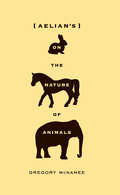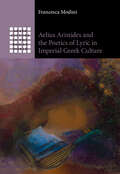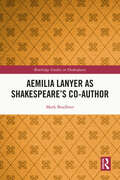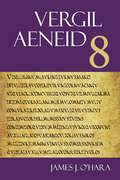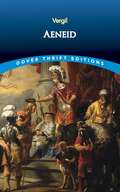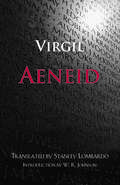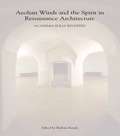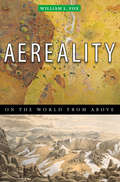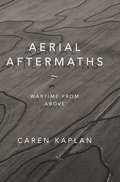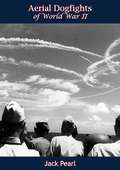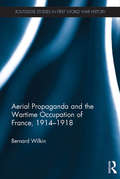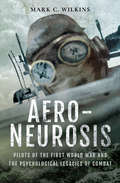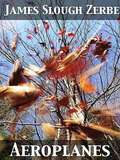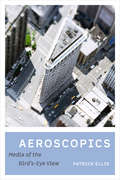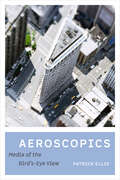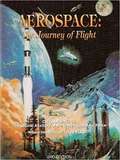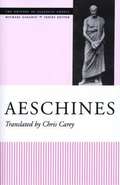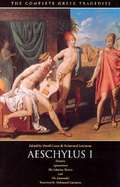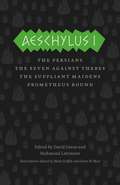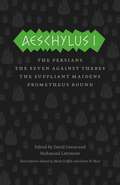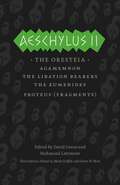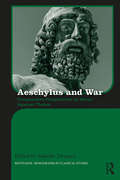- Table View
- List View
Aelian's On the Nature of Animals
by Gregory McnameeNot much can be said with certainty about the life of Claudius Aelianus, known to us as Aelian. He was born sometime between A.D. 165 and 170 in the hill town of Praeneste, what is now Palestrina, about twenty-five miles from Rome, Italy. He grew up speaking that town's version of Latin, a dialect that other speakers of the language seem to have found curious, but-somewhat unusually for his generation, though not for Romans of earlier times-he preferred to communicate in Greek. Trained by a sophist named Pausanias of Caesarea, Aelian was known in his time for a work called Indictment of the Effeminate, an attack on the recently deceased emperor Marcus Aurelius Antoninus, who was nasty even by the standards of Imperial Rome. He was also fond of making almanac-like collections, only fragments of which survive, devoted to odd topics such as manifestations of the divine and the workings of the supernatural.His De Natura Animalium (On the Nature of Animals) has a similar patchwork quality, but it was esteemed enough in his time to survive more or less whole, and it is about all that we know of Aelian's work today. A mostly randomly ordered collection of stories that he found interesting enough to relate about animals-whether or not he believed them-Aelian's book constitutes an early encyclopedia of animal behavior, affording unparalleled insight into what ancient Romans knew about and thought about animals-and, of particular interest to modern scholars, about animal minds.If the science is sometimes sketchy, the facts often fanciful, and the history sometimes suspect, it is clear enough that Aelian had a fine time assembling the material, which can be said, in the most general terms, to support the notion of a kind of intelligence in nature and that extends human qualities, for good and bad, to animals. His stories, which extend across the known world of Aelian's time, tend to be brief and to the point, and many return to a trenchant question: If animals can respect their elders and live honorably within their own tribes, why must humans be so appallingly awful?Aelian is as brisk, as entertaining, and as scholarly a writer as Pliny, the much better known Roman natural historian. That he is not better known is simply an accident: he has not been widely translated into English, or indeed any European language. This selection from his work will introduce readers to a lively mind and a witty writer who has much to tell us.
Aelian's On the Nature of Animals
by Gregory McnameeNot much can be said with certainty about the life of Claudius Aelianus, known to us as Aelian. He was born sometime between A.D. 165 and 170 in the hill town of Praeneste, what is now Palestrina, about twenty-five miles from Rome, Italy. He grew up speaking that town's version of Latin, a dialect that other speakers of the language seem to have found curious, but-somewhat unusually for his generation, though not for Romans of earlier times-he preferred to communicate in Greek. Trained by a sophist named Pausanias of Caesarea, Aelian was known in his time for a work called Indictment of the Effeminate, an attack on the recently deceased emperor Marcus Aurelius Antoninus, who was nasty even by the standards of Imperial Rome. He was also fond of making almanac-like collections, only fragments of which survive, devoted to odd topics such as manifestations of the divine and the workings of the supernatural.His De Natura Animalium (On the Nature of Animals) has a similar patchwork quality, but it was esteemed enough in his time to survive more or less whole, and it is about all that we know of Aelian's work today. A mostly randomly ordered collection of stories that he found interesting enough to relate about animals-whether or not he believed them-Aelian's book constitutes an early encyclopedia of animal behavior, affording unparalleled insight into what ancient Romans knew about and thought about animals-and, of particular interest to modern scholars, about animal minds.If the science is sometimes sketchy, the facts often fanciful, and the history sometimes suspect, it is clear enough that Aelian had a fine time assembling the material, which can be said, in the most general terms, to support the notion of a kind of intelligence in nature and that extends human qualities, for good and bad, to animals. His stories, which extend across the known world of Aelian's time, tend to be brief and to the point, and many return to a trenchant question: If animals can respect their elders and live honorably within their own tribes, why must humans be so appallingly awful?Aelian is as brisk, as entertaining, and as scholarly a writer as Pliny, the much better known Roman natural historian. That he is not better known is simply an accident: he has not been widely translated into English, or indeed any European language. This selection from his work will introduce readers to a lively mind and a witty writer who has much to tell us.
Aelius Aristides and the Poetics of Lyric in Imperial Greek Culture (Greek Culture in the Roman World)
by Francesca ModiniThis book is the first study of the persistence and significance of ancient lyric in imperial Greek culture. Redefining lyric reception as a phenomenon ranging from textual engagement with ancient poems to the appropriation of song traditions, Francesca Modini reconsiders the view of imperial culture (paideia) as dominated by Homer and fifth-century Attic literature. She argues that textual knowledge of lyric allowed imperial writers to show a more sophisticated level of paideia, and her analysis further reveals how lyric traditions mobilised distinctive discourses of self-fashioning, local identity, community-making and power crucial for Greeks under Rome. This is most evident in the works of Aelius Aristides, who reconfigured ancient lyric to shape his rhetorical persona and enhance his speeches to imperial communities. Exploring Aristides' lyric poetics also changes how we interpret his reconstruction of the classical tradition and his involvement in the complex politics of the Empire.
Aemilia Lanyer as Shakespeare’s Co-Author (Routledge Studies in Shakespeare)
by Mark BradbeerThis book presents original material which indicates that Aemilia Lanyer – female writer, feminist, and Shakespeare contemporary – is Shakespeare’s hidden and arguably most significant co-author. Once dismissed as the mere paramour of Shakespeare’s patron, Lord Hunsdon, she is demonstrated to be a most articulate forerunner of #MeToo fury. Building on previous research into the authorship of Shakespeare’s works, Bradbeer offers evidence in the form of three case studies which signal Aemilia’s collaboration with Shakespeare. The first case study matches the works of "George Wilkins" – who is currently credited as the co-author of the feminist Shakespeare play Pericles (1608) – with Aemilia Lanyer’s writing style, education, feminism and knowledge of Lord Hunsdon’s secret sexual life. The second case-study recognizes Titus Andronicus (1594), a play containing the characters Aemilius and Bassianus, to be a revision of the suppressed play Titus and Vespasian (1592), as authored by the unmarried pregnant Aemilia Bassano, as she then was. Lastly, it is argued that Shakespeare’s clowns, Bottom, Launce, Malvolio, Dromio, Dogberry, Jaques, and Moth, arise in her deeply personal war with the misogynist Thomas Nashe. Each case study reveals new aspects of Lanyer’s feminist activism and involvement in Shakespeare’s work, and allows for a deeper analysis and appreciation of the plays. This research will prove provocative to students and scholars of Shakespeare studies, English literature, literary history, and gender studies.
Aeneid 8 (The Focus Vergil Aeneid Commentaries)
by Vergil Mr James J. O'Hara Randall GanibanVergil: Aeneid 8 is part of a new series of commentaries on the Aeneid. Each volume adapts with extensive revisions and additions the commentaries of T. E. Page (1884, 1900), and is edited by a scholar of Roman epic. The present volume offers the Latin text of Book 8 along with maps, extensive notes, and commentary designed to meet the needs of intermediate students of Latin. A two-volume edition of the entire Aeneid designed to meet the needs of advanced students will be derived from the series.
Aeneid: Aeneid, Book Viii: A Vocabulary And Test Papers; By Tutors Of University Correspondence College (classic Reprint) (Dover Thrift Editions: Poetry)
by VergilConsidered the greatest Roman poet, Vergil spent over a decade working on this monumental epic poem, which has been a source of literary inspiration and poetic grandeur for more than 2,000 years. Its twelve books tell the heroic story of Aeneas, a Trojan who escaped the burning ruins of Troy to found a new city in the west. This city, Lavinium, was the parent city of Rome.Drawn by divine destiny after the fall of Troy, Aeneas sailed westward toward the land of the Tiber. After many adventures, he and his men were shipwrecked on the shores of Carthage, where Aeneas and Queen Dido fell in love. Reminded of his duty, however, Aeneas sailed on. After visiting his father in the underworld, Aeneas saw the future of the Roman people and their exploits in peace and war. Eventually he arrived in Italy, where he and his men struggled valiantly to secure a foothold for the founding of Rome.Vast in scope, crowded with exciting adventure and heroic deeds, the Aeneid was Vergil's imagined account of Roman beginnings and a tribute to the history, character and achievements of the Roman people. On the other hand, its depth, vision and empathy with human suffering make the poem relevant to the general human condition. Now this enduring multileveled masterpiece is available in this republication of a standard unabridged translation, the most inexpensive complete version available.
Aeneid: Books Ix. , X (classic Reprint) (Hackett Classics)
by VirgilLong a master of the crafts of Homeric translation and of rhapsodic performance, Stanley Lombardo now turns to the quintessential epic of Roman antiquity, a work with deep roots in the Homeric tradition. With characteristic virtuosity, he delivers a rendering of the Aeneid as compelling as his groundbreaking translations of the Iliad and the Odyssey, yet one that--like the Aeneid itself--conveys a unique epic sensibility and a haunting artistry all its own.W. R. Johnson's Introduction makes an ideal companion to the translation, offering brilliant insight into the legend of Aeneas; the contrasting roles of the gods, fate, and fortune in Homeric versus Virgilian epic; the character of Aeneas as both wanderer and warrior; Aeneas' relationship to both his enemy Turnus and his lover Dido; the theme of doomed youths in the epic; and Virgil's relationship to the brutal history of Rome that he memorializes in his poem.A map, a Glossary of Names, a Translator's Preface, and Suggestions for Further Reading are also included.
Aeolian Winds and the Spirit in Renaissance Architecture: Academia Eolia Revisited
by Barbara KendaWritten by scholars of international stature, Aeolian Winds and the Spirit in Renaissance Architecture presents studies of Renaissance pneumatology exploring the relationship between architecture and the disciplines of art and science. One of the principle goals of Renaissance architects was to augment the powers of pneuma so as to foster the art of well-being. Central to the study of pneumatic architecture are six Italian villas connected together by a ventilating system of caves and tunnels, including Eolia, in which Trento established an academic circle of scholars that included Palladio, Tazzo and Ruzzante. Picking up on current interest in environmental issues, Aeolian Winds and the Spirit in Renaissance Architecture reintroduces Renaissance perspectives on the key relationships in environmental issues between architecture and art and science. This beautifully illustrated and unprecedented study will illuminate the studies of any architecture or Renaissance student or scholar.
Aereality: On the World from Above
by William FoxWilliam Fox's writing for the last several years has been focused on how we construct aerial views, either physically (by flying) or in our imaginations.In Aereality, he flies over earthworks in Nevada and Utah, soars through the world's largest open pit mine, and surveys Los Angeles, circumnavigating large swaths of true American urban sprawl. On the East Coast, he examines the elevated art of the Hudson River Valley and New York City. And finally, in Australia, Fox examines the history and current practice of both Euro–Australian and Aboriginal aerial views, and searches for the cognitive roots of our aerial imagination.Accompanying Fox throughout his travels is a rolling cast of enlightened fliers: geographers, museum curators, landscape photographers, anthropologists, and artists. He traverses the sky in prop planes, helicopters, and hot air balloons, all with the ultimate goal of knowing and experiencing the earth from the air.
Aerial Aftermaths: Wartime from Above
by Caren KaplanFrom the first vistas provided by flight in balloons in the eighteenth century to the most recent sensing operations performed by military drones, the history of aerial imagery has marked the transformation of how people perceived their world, better understood their past, and imagined their future. In Aerial Aftermaths Caren Kaplan traces this cultural history, showing how aerial views operate as a form of world-making tied to the times and places of war. Kaplan’s investigation of the aerial arts of war—painting, photography, and digital imaging—range from England's surveys of Scotland following the defeat of the 1746 Jacobite rebellion and early twentieth-century photographic mapping of Iraq to images taken in the immediate aftermath of 9/11. Throughout, Kaplan foregrounds aerial imagery's importance to modern visual culture and its ability to enforce colonial power, demonstrating both the destructive force and the potential for political connection that come with viewing from above.
Aerial Dogfights of World War II
by Jack PearlIT WAS KILL OR BE KILLED, IN A BATTLE FOR SUPREMACY IN THE SKIES…In a sense, technical advances have written finis to the Golden Age of the aerial dogfight. Modern jets, radar sights, electronically operated triggers and missiles are eliminating the human factor.In a World War II fighter plane the dimensions of war were reduced to basics—man versus man. This was war at its more personal level, in which a pilot met the enemy in an intimate struggle for survival.Here in this unforgettable book is a fitting tribute to these aces of the past—hair-raising accounts of aerial dogfights which occurred in the great land and sea battles in Europe, Africa and the Pacific.
Aerial Propaganda and the Wartime Occupation of France, 1914-18 (Routledge Studies in First World War History)
by Bernard WilkinAerial Propaganda and the Wartime Occupation of France, 1914-1918 explores the combined role played by the French and British Governments and Armies in creating and distributing millions of aerial newspapers and leaflets aimed at the French population trapped behind German lines. Drawing on extensive research and French, German and British primary sources, the book highlights a previously unknown aspect of psychological warfare that challenges the established interpretation that the occupied populations lived in a state of total isolation and that the Allied governments had no desire to provide them with morale support. Instead a very different picture emerges from this study, which demonstrates that aerial propaganda not only played a fundamental role in raising morale in the occupied territories but also fuelled resistance and clandestine publications. This book demonstrates that the existing historiographical portrayal of the occupied civilian as an uninformed victim must be replaced by a more nuanced interpretation.
Aero-Neurosis: Pilots of the First World War and the Psychological Legacies of Combat
by Mark C. Wilkins&“Lays bare the grim reality of life on a frontline squadron . . . the comprehensive physical, emotional, and mental decline these aviators endured.&” —Donna&’s Book Blog The young men who flew and fought during the First World War had no idea what was awaiting them. The &“technology shock&” that coalesced at the Western Front was not envisaged by any of the leadership or medical establishment. Despite the attendant horrors many men experienced, some felt that the dynamic context of aerial combat was something that, after the war, they still longed for . . . Doctors argued over best practice for treatment. Of course, the military wanted these men to return to duty as quickly as possible; with mounting casualties, each country needed every man. Aviation psychiatry arose as a new subset of the field, attempting to treat psychological symptoms previously unseen in combatants. The unique conditions of combat flying produced a whole new type of neurosis. Terms such as &“Aero-neurosis&” were coined to provide the necessary label yet, like shell shock, they were inadequate when it came to describing the full and complete shock to the psyche. Mark C. Wilkins finds the psychology undergirding historical events fascinating and of chief interest to him as an historian. He has included expert medical testimony and excerpts where relevant in a fascinating book that explores the legacies of aerial combat, illustrating the ways in which pilots had to amalgamate their suffering and experiences into their postwar lives. Their attempts to do so can perhaps be seen as an extension of their heroism. &“An original and absorbing study of the psychological factors of the first air war.&” —Firetrench
Aeroplanes
by James Slough Zerbe"Aeroplanes" by James Slough Zerbe is a comprehensive guide focusing on the theories and practical application of flying machines. The book explores topics such as the principles of aeroplane flight, different methods of controlling flying machines, the history of kites and gliders, propeller design, and the role of aeroplanes in war. It provides detailed explanations on aeroplane construction, power application, and the technical aspects of propeller design. With a blend of technical terminology and practical insights, the book offers a thorough overview of the principles and technologies involved in the development and operation of flying machines.
Aeroscopics: Media of the Bird's-Eye View
by Patrick EllisIn 1900, Paris had no skyscrapers, no tourist helicopters, no drones. Yet well before aviation made aerial views more accessible, those who sought such vantages had countless options available to them. They could take in the vista from an observation ride, see a painting of the view from Notre-Dame, or overlook a miniature model city. In Aeroscopics, Patrick Ellis offers a history of the view from above, written from below. Richly illustrated and premised upon extensive archival work, this interdisciplinary study reveals the forgotten media available to the public in the Balloon Era and after. Ellis resurrects these neglected spectacles as "aeroscopics," opening up new possibilities for the history of aerial vision.
Aeroscopics: Media of the Bird's-Eye View
by Patrick EllisIn 1900, Paris had no skyscrapers, no tourist helicopters, no drones. Yet well before aviation made aerial views more accessible, those who sought such vantages had countless options available to them. They could take in the vista from an observation ride, see a painting of the view from Notre-Dame, or overlook a miniature model city. In Aeroscopics, Patrick Ellis offers a history of the view from above, written from below. Richly illustrated and premised upon extensive archival work, this interdisciplinary study reveals the forgotten media available to the public in the Balloon Era and after. Ellis resurrects these neglected spectacles as "aeroscopics," opening up new possibilities for the history of aerial vision.
Aerospace Science: A Journey into Aviation History
by Linda F. SackieAerospace Science: A Journey Into Aviation History is a course about aviation history focusing on the development of flight throughout the centuries. It starts with ancient civilizations, then progresses through time to modern days. It emphasizes civilian and military contributions to aviation, the development and modernization of the United States Air Force, and a brief history of astronomy and space exploration.
Aerospace: The Journey of Flight (Second Edition)
by Jeff MontgomeryA tremendous amount of cooperation and teamwork accompanied the production of this book, and we are extremely grateful to the many dedicated people and organizations who contributed their time, talents, and resources.
Aeschines
by Chris CareyThis is the third volume in the Oratory of Classical Greece series. Planned for publication over several years, the series will present all of the surviving speeches from the late fifth and fourth centuries B.C. in new translations prepared by classical scholars who are at the forefront of the discipline. These translations are especially designed for the needs and interests of today's undergraduates, Greekless scholars in other disciplines, and the general public. Classical oratory is an invaluable resource for the study of ancient Greek life and culture. The speeches offer evidence on Greek moral views, social and economic conditions, political and social ideology, and other aspects of Athenian culture that have been largely ignored: women and family life, slavery, and religion, to name just a few. This volume contains the three surviving speeches of Aeschines (390-? B.C.). His speeches all revolve around political developments in Athens during the second half of the fourth century B.C. and reflect the internal political rivalries in an Athens overshadowed by the growing power of Macedonia in the north. The first speech was delivered when Aeschines successfully prosecuted Timarchus, a political opponent, for having allegedly prostituted himself as a young man. The other two speeches were delivered in the context of Aeschines' long-running political feud with Demosthenes. As a group, the speeches provide important information on Athenian law and politics, Demosthenes and his career, sexuality and social history, and the historical rivalry between Athens and Macedonia.
Aeschylus I: Agamemnon, The Libation Bearers, The Eumenides (The Complete Greek Tragedies #1)
by Aeschylus David Grene Richmond Lattimore"These authoritative translations consign all other complete collections to the wastebasket."--Robert Brustein, The New Republic. "This is it. No qualifications. Go out and buy it everybody."--Kenneth Rexroth, The Nation. "The translations deliberately avoid the highly wrought and affectedly poetic; their idiom is contemporary.... They have life and speed and suppleness of phrase."--Times Education Supplement. "These translations belong to our time. A keen poetic sensibility repeatedly quickens them; and without this inner fire the most academically flawless rendering is dead."--Warren D. Anderson, American Oxonian. "The critical commentaries and the versions themselves... are fresh, unpretentious, above all, functional."--Commonwealth. "Grene is one of the great translators."--Conor Cruise O'Brien, London Sunday Times. "Richmond Lattimore is that rara avis in our age, the classical scholar who is at the same time an accomplished poet."--Dudley Fitts, New York Times Book Review.
Aeschylus I: The Complete Greek Tragedies, Third Edition
by David Grene Richmond Lattimore"Aeschylus I" contains The Persians, translated by Seth Benardete; The Seven Against Thebes, translated by David Grene; The Suppliant Maidens, translated by Seth Benardete; and Prometheus Bound, translated by David Grene. Sixty years ago, the University of Chicago Press undertook a momentous project: a new translation of the Greek tragedies that would be the ultimate resource for teachers, students, and readers. They succeeded. Under the expert management of eminent classicists David Grene and Richmond Lattimore, those translations combined accuracy, poetic immediacy, and clarity of presentation to render the surviving masterpieces of Aeschylus, Sophocles, and Euripides in an English so lively and compelling that they remain the standard translations. Today, Chicago is taking pains to ensure that our Greek tragedies remain the leading English-language versions throughout the twenty-first century. In this highly anticipated third edition, Mark Griffith and Glenn W. Most have carefully updated the translations to bring them even closer to the ancient Greek while retaining the vibrancy for which our English versions are famous. This edition also includes brand-new translations of Euripides "Medea," "The Children of Heracles," "Andromache," and "Iphigenia among the Taurians," fragments of lost plays by Aeschylus, and the surviving portion of Sophocles s satyr-drama "The Trackers. " New introductions for each play offer essential information about its first production, plot, and reception in antiquity and beyond. In addition, each volume includes an introduction to the life and work of its tragedian, as well as notes addressing textual uncertainties and a glossary of names and places mentioned in the plays. In addition to the new content, the volumes have been reorganized both within and between volumes to reflect the most up-to-date scholarship on the order in which the plays were originally written. The result is a set of handsome paperbacks destined to introduce new generations of readers to these foundational works of Western drama, art, and life. "
Aeschylus I: The Persians, The Seven Against Thebes, The Suppliant Maidens, Prometheus Bound (The Complete Greek Tragedies)
by AeschylusThe third edition of this volume includes newly revised, authoritative and compelling translations of four timeless works by the Ancient Greek tragedian.Aeschylus I contains “The Persians,” translated by Seth Benardete; “The Seven Against Thebes,” translated by David Grene; “The Suppliant Maidens,” translated by Seth Benardete; and “Prometheus Bound,” translated by David Grene. For this edition, Mark Griffith and Glenn W. Most have carefully updated these translations to bring them even closer to the ancient Greek while retaining the vibrancy for which the renowned University of Chicago Press series is famous. This edition also includes brand-new translations of Euripides’ Medea, The Children of Heracles, Andromache, and Iphigenia among the Taurians, fragments of lost plays by Aeschylus, and the surviving portion of Sophocles’s satyr-drama The Trackers. New introductions for each play offer essential information about its first production, plot, and reception in antiquity and beyond. In addition, each volume includes an introduction to the life and work of its tragedian, as well as notes addressing textual uncertainties and a glossary of names and places mentioned in the plays. The entire series has also been reorganized both within and between volumes to reflect the most up-to-date scholarship on the order in which the plays were originally written.
Aeschylus II: The Oresteia (The Complete Greek Tragedies)
by AeschylusThis updated translation of the Oresteia trilogy and fragments of the satyr play Proteus includes an extensive historical and critical introduction. In the third edition of The Complete Greek Tragedies, Mark Griffith and Glenn W. Most have carefully updated the translations to bring them even closer to the ancient Greek while retaining their vibrancy for which the Grene and Lattimore versions are famous. New introductions for each play offer essential information about its first production, plot, and reception in antiquity and beyond.Each volume also includes an introduction to the life and work of the tragedian and an explanation of how the plays were first staged, as well as notes addressing textual uncertainties and a glossary of names and places mentioned in the plays. The result is a series of lively and authoritative translations offering a comprehensive introduction to these foundational works of Western drama.
Aeschylus and War: Comparative Perspectives on Seven Against Thebes (Routledge Monographs in Classical Studies)
by Isabelle TorranceThis volume brings together a group of interdisciplinary experts who demonstrate that Aeschylus’ Seven Against Thebes is a text of continuing relevance and value for exploring ancient, contemporary and comparative issues of war and its attendant trauma. The volume features contributions from an international cast of experts, as well as a conversation with a retired U.S. Army Lt. Col., giving her perspectives on the blending of reality and fiction in Aeschylus’ war tragedies and on the potential of Greek tragedy to speak to contemporary veterans. This book is a fascinating resource for anyone interested in Aeschylus, Greek tragedy and its reception, and war literature.
